Dog Becoming Infested With Fleas Continuously
How to Get Rid Of Fleas for Good

I learned first hand a few years ago that getting rid of fleas is no easy task. It sounds simple enough, but the problem is they have a tendency to keep coming back.
After 20 years of owning pets I'd never had to deal with them before. So I went to the store, loaded up a bunch of flea products and got to work. After each treatment I'd let out a sigh of relief thinking they were finally gone, and yet a few days later the fleas would be back.
The products I tried only offered temporary solutions, they kept coming back after a week or two. Don't let yourself fall into that same trap. In this article I'll share with you how to get rid of fleas on your dog, which methods work best, and why they're so tricky to get rid of.
How to Get Rid of Fleas For Good
Getting rid of fleas on your dog is difficult, I'm not going to lie. The key to getting rid of them comes down to understanding how different flea treatments work, and coming up with a combination that will stop them at each stage of their life cycle. In this article you'll learn:
- How to check your dog for fleas at home
- Steps you can take to prevent your dog from getting fleas
- An overview of the different flea treatments available
- How to come up with a combination of treatments that will get rid of fleas
No one likes dealing with fleas. But the good news is this post will give you all the information you need to get rid of fleas for good.
Why Are Fleas So Hard to Get Rid Of?
Fleas are notoriously hard to get rid of because they're persistent — just like cockroaches. As soon as you think you've gotten rid of them all more start popping up. Getting rid of fleas requires treatment at all of their life stages on both the animal and their environment.
Despite my repeated attempts at remedying the flea infestation on my own I was failing. They kept coming back. I was using flea shampoos and medication on my dog; in my mind that should have taken care of everything. What I failed to do was treat my home. There were eggs and larvae embedded in the carpet, and after a few days they'd hatch and I'd spot them on my dog.
When getting rid of fleas persistence pays off. You need to treat both your dog and your home if you want to prevent them from coming back.
Once you understand the flea's life cycle it's much easier to come up with your own treatment plan. Instead of just focusing on the visible fleas you need to ensure you're also eliminating eggs and larvae. If you're only killing adult fleas it's just a matter of time before all the eggs hatch into a whole new infestation.
There are Over 1600 Species of Fleas
Fleas are the most common cause of scratching and itching in dogs. They are very active insects, feeding on blood from both dogs and people. They're more than just an annoyance; they can also carry a number of other potentially dangerous bacteria that can be passed onto your dog.
Crawling around on your dogs skin is irritating enough but some dogs can develop severe allergies to them. Puppies and some small breeds have been known to become anemic and gravely ill due to blood loss from severe infestations.
There are over 1600 species of fleas – 95% of them thrive off mammals. The cat flea accounts for most of the infestations found in North America that affect our pets. The cat flea is the most common and abundant flea species on Earth. Since more than three quarters of the fleas life cycle is spent somewhere other than on the host treating your dog only will usually not get rid of fleas. The environment has to be treated as well.
I've been there. I had a flea infestation five years ago and it took multiple treatment options and a few repetitions before I finally broke the cycle. It wasn't easy but once I understood that it took more than just a simple flea collar or spray I was able to emerge victorious and rid my home and dog of fleas for good.
Getting rid of fleas takes a lot of persistence because you need to manage the fleas at each of their life cycles on both the host and the environment. Just getting rid of the active adult fleas on your dog isn't enough. Flea eggs can lay dormant for as long as one year if their environment isn't favorable.
Factors That Increase the Likelihood of Your Dog Getting Fleas
Dogs that live in hot, damp climates have a higher risk of getting fleas since fleas thrive in these warm environments. Dogs who live with other pets have a higher chance of becoming infected because they're likely to jump from animal to another.
The more visitors you have in your yard the higher the chances of your dog running into a flea infestation. Squirrels, raccoons, feral cats, and small rodents are common carriers of fleas and ticks.
Dogs are at the highest risk of getting fleas in the summer months, but flea infestations have been observed year round.
The Southeast, Southern Plains, and Pacific Northwest demonstrated the highest prevalence of fleas for both dogs and cats. Warmer and more humid environments benefit flea development; however, other factors, such as the presence of feral animals, degree and vigor of flea control used, and seasonal changes, may play a role in flea burden and exposure. – Flea Prevalence in Dogs & Cats, Banfield Pet Hospital
Health Complications of Fleas On Your Dog
If your dog has fleas it's important to treat them quickly in order to avoid further infestation. In addition there are a few complications to look out for if you suspect your dog has fleas. Young puppies carry an increased risk of developing chronic blood loss due to anemia when they get fleas, and some dogs can develop a severe allergy to the chemicals found in flea saliva.
Fleas On Your Puppy Can Be Fatal
Puppies that get fleas have a high risk of developing anemia because of their small size. Anemia is chronic blood loss that's often caused by fleas and hookworms in puppies. A puppies gums should be pink, if they're pale or white it's likely your puppy is anemic. Other symptoms of anemia are listlessness and a cold body temperature.
Since fleas can consume 15 times their own body weight in blood, they can cause anemia or a significant amount of blood loss over time. This is especially problematic in young puppies, where an inadequate number of red blood cells can be life-threatening to some dogs. Signs of parasitic anemia include pale gums, cold body temperature and listlessness. – APSCA
Puppies are at an increased risk of developing anemia when they get fleas. If you suspect your puppy has fleas a trip to the vet is highly recommended to keep the infestation under control. It doesn't take long for a young dog or puppy to suffer severe damage from a flea infestation; if you suspect your puppy has fleas take him to the vet immediately.
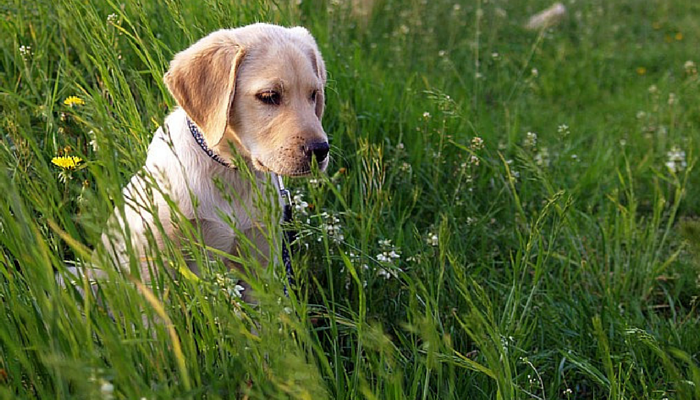
Puppies that get fleas have an increased risk of developing Anemia, which can be a life threatening condition. A trip to your veterinarian is recommended if you suspect your puppy has fleas.
Flea Allergy Dermatitis in Dogs
Some dogs and cats can develop an itchy skin disease from their sensitivity to fleas. Affected animals develop an allergy to the chemicals found in flea saliva. What might appear as simple flea bites on your dog can quickly turn into a severe reaction if left untreated. Normal flea bites don't get swollen and red. A normal flea infestation doesn't cause hair loss in dogs. If your dog experiences some of these symptoms it's time for a trip to the vet for treatment.
Symptoms of flea allergy dermatitis (FAD) include:
- Redness
- Bumps
- Pus filled Bumps (pustules)
- Crusts and scabs
- Hair loss if severe
The most common areas affected by Flea Allergy Dermatitis are the lower back, tail, neck, and the back of your pets legs. It's the most common skin disease among domesticated dogs in the US. And secondary bacterial or yeast infections can complicate the treatment of FAD.
Flea Allergic Dermatitis (FAD) is the most common skin disease in dogs and cats. For the FAD patient, 100% flea control is essential for the pet to remain symptom-free. Regrettably, fleas in our homes may survive in low numbers year-round, making flea control maintenance ongoing. – Pet Allergies are Big Business Columbus CEO
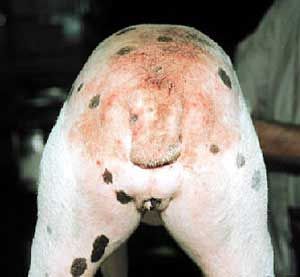
Flea allergy dermatitis is the most common skin disease diagnosed in domesticated dogs in the US.
Fleas Can Transmit Other Diseases to Dogs
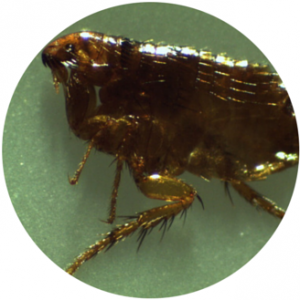
Adult flea
Fleas can also transmit other potentially dangerous diseases to your dog. Fleas are intermediate hosts for Dipylidium caninum tapeworms. Dogs that ingest adult fleas during their itching and scratching are at high risk for becoming infected with tapeworms. The dog ingests the immature form of the tapeworm from the flea and it then develops into an adult in the dog's intestines.
Tapeworms can be treated with medication from your veterinarian but unless you also get rid of the fleas your dog has a high likelihood of becoming reinfected with tapeworms.
Fleas also act as carriers of other infectious microorganisms including Yersinia pestis , tularemia,and murine typhus. It's important to have your dog checked by a veterinarian if they have fleas to make sure your dog hasn't also been infected by any of these secondary infections.
When you live in a multi pet household getting a handle on the infestation will be much more challenging. Not only will you need to treat your home but you'll need to keep an eye on each of your pets for symptoms of fleas.

Dipylidium caninum (the double-pored dog tapeworm) mainly infects dogs and cats, but is occasionally found in humans.. – CDC
The Symptoms of Fleas on Dogs
The most common symptom of fleas on your pets is itching. But itching alone doesn't mean your dog has fleas — it's also one of the most common symptoms in many other conditions such as allergies. If you think your dog has fleas check for the following symptoms:
- Itching & Scratching
- Red bumps
- Oozing sores
- Hair loss
- Flea dirt (flea poop)
Itching and scratching. Usually the first thing an owner will notice when their dog has fleas. It can be mild or severe. Flea bite dermatitis is a severe skin reaction to fleas; it occurs when a dog either has an allergic reaction to the fleas or becomes hypersensitive due to skin irritation.
Red bumps. These are often found on a dogs belly, hindquarters, or groin. They occur when the dogs skin becomes further irritated by the excessive scratching. Left untreated these can develop into crusty lesions which can lead to secondary infections.
Pus oozing from sores. Commonly caused by a secondary bacterial infection due to the excessive skin mutilation of itching, scratching, licking, and biting. These infections are quite serious and can become life threatening.
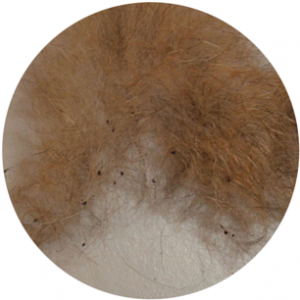
Flea dirt
Patchy areas of hair loss. Alopecia is often seen on a dogs skin where they've been repeatedly scratching. The dog begins to lose hair in these areas due to the repeated irritation and the skin becomes increasingly dry.
Flea dirt. Adult flea feces appear as little specks of dirt on your dogs skin. Sometimes it's hard to tell if you're seeing a flea or flea dirt. If you place one of the specks on a white towel and spray it with water and it turns dark reddish-brown it's flea dirt.
How to Check Your Dog for Fleas
Think your dog might have fleas? There's three simple techniques you can use at home to check.
And remember that itching itself is only one symptom of fleas. If you aren't able to find any fleas on your dog but he continues to itch a trip to the veterinarian is recommended to rule out other causes.
How to Visually Check Your Dog for Fleas
Adult fleas although small (1/16 – 1/8 inch) are easy to spot with the human eye. They move very fast and can jump pretty high so you might only catch quick glimpses. They are flat bodied and brown, sometimes appearing almost black. The more blood they've ingested the lighter they will appear. Have your dog lay on it's side. Fleas are often found in warm, protected areas such as the armpits, abdomen and groin.
A visual check alone can be challenging. When I suspected out dog had fleas I was doing a couple visual checks a day and wasn't spotting anything. After five days I finally caught a glimpse of a flea – and it moved so fast I almost questioned whether I'd actually seen it or not. If you suspect your dog might have fleas I'd start with a white towel test or look for signs of flea dirt.
If I hadn't waited to get flea treatment until I saw an actual live flea our infestation would have been much milder.
Check For Fleas With a Flea Comb
You can purchase a flea comb at most pet supply stores. Run the comb along your dogs fur with just enough pressure to touch the skin. The comb's teeth are designed to catch and pull fleas from your dogs coat where they are hiding.
If you do catch any fleas with a comb you'll want to have a bowl of soapy water on hand to drown any fleas you catch.
Use The White Towel Test to Check For Fleas on Your Dog
If you see little dark colored specks on your dogs skin and aren't sure if they're fleas or not use the white towel test. Brush or comb your dog while they're laying on a white towel. When those specks fall off your dog onto the towel spray them with a spray bottle. If they turn a dark reddish-brown color you're seeing flea feces, otherwise known as flea dirt.
The Life Cycle of Fleas Explained
It's hard to get rid of fleas because of their life cycle. We usually use treatments that kill adult fleas, but not all options work when it comes to getting rid of all the eggs, larva & pupae that they leave behind.
Even if you spot fleas on your dog you should realize that only a small proportion are on your dog at any given time. The eggs, larvae, and pupae are actually found on the ground, often embedded in carpet. On average fleas take about a month to from egg to adult. The female flea lays her eggs about 2 days after mating and the eggs take an additional 3-6 days to hatch into larvae.
The larvae feeds off of the mother's flea dirt and in about a week they start spinning a cocoon. Under normal circumstances the cocooned larva, now called pupae, would remain in this state for about 2 weeks before it becomes an adult flea. If the environment is too cold this stage can be extended by up to one year.
Flea populations are evenly distributed, with about 50% eggs, 35% larvae, 10% pupae, and 5% adults. – Vet Medicine
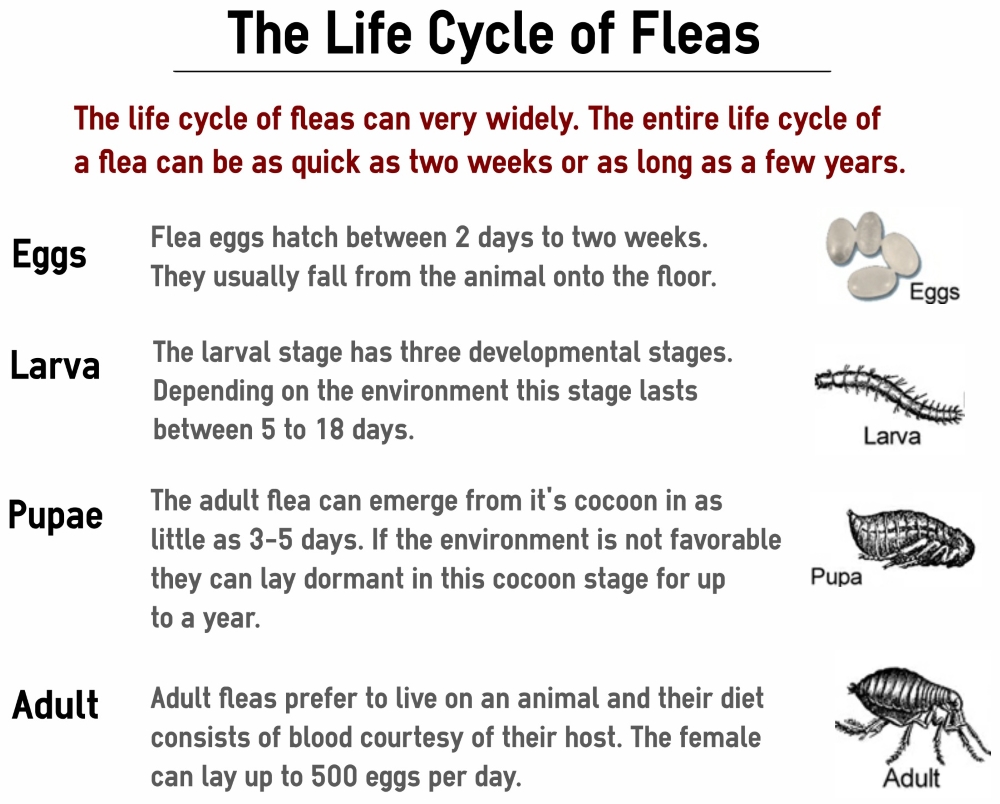
Flea life cycle
Getting Rid of Fleas Includes Eliminating Eggs, Larvae, Pupae, and Adults
Unfortunately those adult fleas you see on your dog are only a small part of the problem. The eggs, larvae & pupae also have to be addressed to get rid of fleas.
Most pupae will be found on the carpet or ground where your dog spends a lot of his time. Common problem areas for fleas are near your dogs food bowl, in their bed, and at the base of furniture.
Once the fleas are fully developed they'll jump onto their new host. They're stimulated by air currents, carbon dioxide, touch, and light. If you suspect you have fleas you can wear white socks around the areas your dog hangs out. The vibrations and pressure walking creates should trigger the adult fleas to jump. They'll stick out against the white sock fibers.
Because pupae can lay dormant for months it's important to continually treat the environment. Repeated vacuuming is recommended to remove flea eggs from your carpets & floors. Make sure to empty your vacuum immediately afterwards and take it outside, those eggs can hatch while inside your vacuum bag.
Be sure to pay close attention to the places where your dog hangs out a lot. Wash your dogs bedding frequently to help stop the cycle, and if your dog is allowed on the furniture clean your couches & chairs. Clean and treat any other areas your dog spends a considerable amount of time in.
Adult fleas, the ones you can see, account for only 5% of the total flea population. That means for every 5 live fleas you see, 100 more are in various stages of becoming an adult. – At War With the Common Flea
To Get Rid of Fleas You Need To Eliminate the Whole Life Cycle
To effectively eliminate the entire flea life cycle you'll likely have to use more than one treatment option. Because fleas can cause severe reactions in dogs and are known to carry other bacterium it's recommended to have him examined by your veterinarian.
Getting rid of fleas causes a problem for many pet owners when they only treat the animal. To take control of your flea infestation you need to treat both your dog and the environment. During your dogs treatment you might want to consider keeping him indoors as much as possible for a few weeks.
You can still go out for walks but avoid long grasses, sandy areas, fallen leaves, and other animals. You don't want to risk your dog becoming reinfected with new fleas during the treatment stage.
Continue to clean your floors thoroughly. Vacuum your carpets and mop smooth floors to ensure that you're getting rid of all those larvae, eggs & pupae on the ground. Make sure to vacuum under furniture as well since a lot of larvae and eggs can be found at the base of furniture.
Your yard can also be a place for your dog to pick up new fleas. Rake up fallen leaves in your yard and if you see any dark, most spots try and expose it to sunlight. You can use the same sprays you used indoors in your yard or you can opt for a yard & kennel spray that kills fleas and ticks on contact. If you're not a fan of using chemicals there are some natural options such as Vet's Best available that will cover up to 4,500 square feet.
When evaluating the residual performance of a flea product, an effective product's reproductive break point will occur at some time point after the next labeled reapplication interval. If a product is labeled for once-a-month administration and the reproductive break point occurs around Day 21, then the product will probably not be effective in eliminating a flea infestation. – Michael Dryden DVM
Here's an excellent video explaining the life cycle of fleas:
Tips for Managing Fleas with Chemical Preventatives
There's always going to be some risk involved when giving your pet any medication, and flea treatments are no exception. To help reduce any potential health risks for your dog while taking flea medications keep the following tips in mind.
- Follow the exact dosage directions on the label. Don't make assumptions about your pets weight and what dosage he needs. If your dog is at the low end of the dosage scale use the lower dose.
- Watch out for your dogs liver. Flea medications can be tough on a dogs liver while it processes all the extra chemicals. Look into using a dietary supplement that helps aid the livers detoxification efforts and avoid low protein diets. Vitamin E, Zinc, Milk Thistle and Ursodiol are vitamins and supplements that can help improve liver health and function.
- Monitor your dog while trying out any new flea medication, especially if you're trying it for the first time. Check for any adverse reactions such as skin issues, allergies, hair loss, nervousness, salivation, stomach problems and lethargy.
There are a wide variety of flea products available, and they all come with their own risks. Be sure to discuss any concerns you have with your veterinarian.
Just How Many Flea Medications & Treatments Are There?
The worst part about getting rid of fleas is trying to figure out which treatment to use since there's so many to choose from.
The bad news is that not all treatments are effective enough to get rid of fleas on their own. The good news is that understanding that you have kill fleas in all stages of their life cycle will save you a lot of frustration later on.
In order to get rid of fleas for good you need to treat your dog for adult fleas and your home for all the eggs and larvae. So if the first product you choose only kills adult fleas you're going to need to use another method to get rid of all the eggs and larvae.
Treating your dog at the same time as the environment will help reduce the chances of further flea infestations. It's important to remember that eggs & larva can lay dormant for weeks, so only treating your dog can lead to further outbreaks.
Personally I had great success with a prescription flea medication for my dog and vacuuming a couple times a day over the course of week.
And as I mentioned above there's a ton of flea treatments to choose from, so the process of picking one can be overwhelming. To help you I've put together a list of the different kinds of treatments available. From prescription medications to a simple flea collar, here's a break down of the different ways to manage fleas.
Flea Medication Options For Your Dog
The first step in getting rid of fleas is treating your pet. The following list is an explanation of the various flea treatments available, as well as their risks and benefits. Once you know how each of these flea medications work it's recommended taking a trip to the vet for some expert advice. They'll be able to give you more details on what regimen they think is best for your dog.
Only give your pet flea treatment that has been recommended for them. Products suitable for one species may not be suitable for another e.g. some dog flea treatments contain permethrin, an insecticide that is safe for dogs but highly toxic to cats. – How to Get Rid of Fleas, RSPCA
Prescription Medications for Getting Rid of Fleas
Veterinarians can help you come up with a plan to manage your dog's infestation. There are many new prescription medications which can help take some of the frustration of treatment of flea control. Some of these medications stop flea eggs from hatching thus stopping the life cycle thus stopping the life cycle of the flea. These medications can get rid of fleas very quickly.
With no reproduction the flea population will eventually diminish as long as the pet isn't introduced to new flea populations. For severe flea problems you might need to look into a prescription product that kills adult fleas. From personal experience I can tell you these medications work effectively and you can expect to notice a difference almost immediately. Popular brands of prescription flea medication include Sentinel, Comfortis, Trifexis, Revolution, and Advantage.
Prescription flea medications are the most effective at getting rid of fleas quickly. If you opt to go with flea medication from your veterinarian it's likely strong enough to be the only flea treatment you'll need for your dog. And remember to discuss any concerns you have about these medications with your veterinarian.
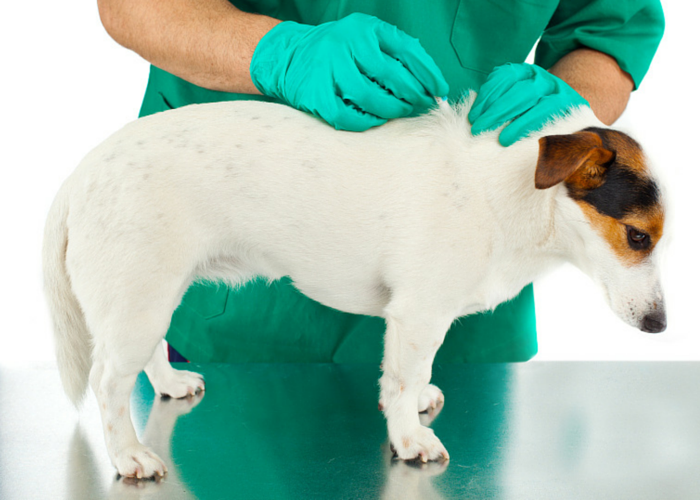
Tick and Flea medication being administered by a veterinarian.
Insect Growth Regulators
Insect growth regulators (IGR's) are insecticides which work to stop the life cycle. IGR is a protein that works on eggs and larvae and stops fleas from reaching maturity so they cannot lay eggs. Many flea bombs and foggers include IGR and are effective at killing fleas, but they don't reach under beds or furniture. Many prescription and non prescription medications contain IGRs.
IGR's work at low concentrations and tend to have very little toxicity. They can be used by themselves to control fleas if you're willing to wait for them to eliminate the entire life cycle. Their will be a noticeable difference in about a week but you won't achieve complete control for a few months using an IGR alone.
Although IGRs are effective at treating eggs & larvae it's important to keep in mind that they have limited results against pupae. Pupae stage fleas are not effected by insecticides because they're so well protected. You may notice a new infestation of fleas a few weeks after treating with an IGR alone because the pupae weren't killed off.
If you opt to use a product with IGR remember that you have to thoroughly clean the environment to get rid of the pupae as well. This is where repeated vacuuming & mopping comes in.
Non Prescription Flea Medications
There are some non prescription medications which kill fleas. They might be less effective than prescription medications but they do help control flea populations. These include flea shampoos, flea powders, flea sprays, and flea collars.
One of the most common medications is the Capstar Flea Treatment. It kills adult fleas within 4 hours.
Although effective against adult fleas Capstar alone won't get rid of an infestation if your home is effected. To get rid of the pupae, larva & eggs remember to clean your floors thoroughly.
Flea Sprays With IGR
There are many flea sprays available, and the most effective ones at killing fleas by themselves are those that contain IGR.
If you want to disrupt the flea life cycle look for one with IGR in it. Focus on the areas that your pet spends a lot of time on and don't forget dark corners and under baseboards. If you're using a spray with IGR try not to vacuum for a week afterward since IGR can have a residual effect.
Natural Flea Spray Options
If you're looking for an alternative to chemical treatments there are some great natural options available.
We had good luck with Vet's Best Flea & Tick spray. It gets rid of adult fleas and eggs, and it's completely natural. It's a non-staining formula that you can use on furniture, bedding & carpets. It's made with peppermint oil & clove extract, and it's safe to use on dogs & cats over 12 weeks old.
Wondercide Natural Flea Spray is a natural alternative that doesn't contain DEET, pyrethrins or other chemical pesticides. It's effective against adult fleas, eggs, larva & pupae. It's a non-staining formula that can be used on your furniture & floors. It contains 10% cedar oil & 90% hydrated silica.
The key to using these natural flea options is to remember that not all of them will interrupt the entire life cycle of fleas. If you use a natural flea spray remember to be persistent when it comes to vacuuming to help get rid of any eggs & larvae that remain. And remember to dispose of the vacuum contents outside to help prevent further outbreaks.
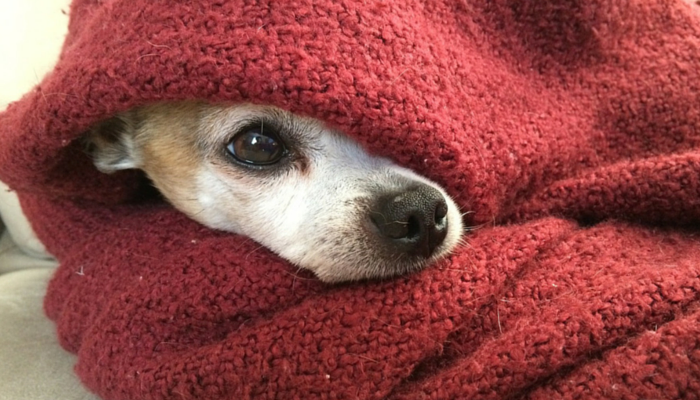
If you're concerned about chemicals in treat flea medications & treatment there are natural options.
Flea Collars
There are a few options when choosing a flea collar; those that are preventative and those that act on an existing infestation and some act as both. As long as the product says "kills fleas" on it you've chosen one that's effective for an existing flea problem.
The quality of flea collars varies greatly; some may last for up to 8 months while others will be done in about a month. There are many brands which are known to not be very effective; ask your veterinarian if they have any brand preferences.
Flea collars are considered short term treatment options. Most are only recommended to be used for 7 days or less. The chemicals in flea collars you'll want to avoid are propoxur and tetrachlorvinphos (TCVP). Consult the GreenPaws Flea and Tick products directory for a complete list of flea treatments and toxicity listings.
Flea collars have lost a lot of popularity in the past decade; they aren't known to be extremely effective and there's been a lot of health concerns regarding their use. Use with caution and make sure to read the label and look out for propoxur & TCVP.
Many flea collars are most effective in the local area (head and neck), which is little help since most fleas prefer the bottom or back end of the pet. Also, most flea collars aren't strong enough to actually kill adult fleas. – PetPlace
Spot on Treatments for Fleas
Spot on treatments are liquid that's applied by pouring it directly onto your pets back. Most last about 30 days. The medicine gets soaked into your pets skin and goes to work instantly. It goes directly into your pets circulatory system and any parasite that ingests your pets blood will cause death to any parasite that ingests it. As long as taken per the directions these treatments should not affect your pets health. Many of the spot on treatments also contain IGR's.
Complaints Regarding Spot On Flea Treatments
There have been complaints that spot on flea treatments for dogs wear off rather quickly, and that they can have adverse health effects on some dogs. After receiving complaints regarding adverse reactions to spot on flea treatments the EPA released a report in 2009 detailing their findings.
The EPA found that young dogs (less than 3 years old) and small-breed dogs (weighing 10-20 pounds) tended to be the most commonly reported for all products. Small breeds were over-represented especially with cyphenothrin- and permethrin-containing products. Chihuahuas, Shih Tzus, Miniature Poodles, Pomeranians, and Bichon Frises appeared to be generally over-represented across the spot-on products (as compared with their respective American Kennel Club popularity rankings). – EPA's Investiation Into Spot On Flea Treatments
The EPA urges owners to use caution when choosing spot on flea treatments, and they're currently working to make the labels and dosing requirements more precise. If you're going to use a spot on flea treatment for your dog please consult your veterinarian with any questions and concerns you might have.
Spot-on flea and tick products can be effective treatments, and many people use the products with no harmful effects to their pets. EPA does not advise pet owners to stop using spot-ons, but asks them to use caution and make informed decisions when selecting treatment methods. – FDA: Safe Use of Spot On Flea & Tick Treatments
Keep Humidity Low For a Few Days to Kill Fleas
To thrive fleas require at least 50% humidity in their environment. If you set out a dehumidifier and keep it under 50% for a few days it will kill most adult fleas and larva. It also helps to prevent the eggs from hatching so make sure to vacuum thoroughly during this time.
While vacuuming repeatedly is generally enough to get rid of a minor flea infestation you can also lower the humidity in your home to help keep more eggs from hatching.
Use a Flea Comb
Flea combs are excellent for getting rid of "stragglers" or checking your dog for fleas at home. A flea comb is great to use immediately after a bath to get rid of any fleas that may have been missed by rinsing. Some flea combs have double rows of teeth which help embed the fleas and can prevent their escape. Use the comb all over your dogs skin and be sure to have a bowl of soapy water nearby to drown any fleas you pick up.
Giving Your Dog a Flea Bath
There are many flea shampoos available for pets. Even with other treatment options you're probably going to want to buy some shampoo to help get rid of all that flea dirt on your dog.
Just remember that flea shampoos can counteract certain flea treatments (such as spot on treatments) on your dog. If you're treating your dog with flea medication read the label to see if bathing your dog will interfere with the results. Some medications suggest waiting 2 weeks before bathing your dog.
When bathing with flea shampoo you'll want to start with the head or neck first so the fleas don't jump upwards onto the dogs face. Be thorough when washing your pet. It's not unusual to see a lot of fleas and dirt come off of your pet in the bath.
We opted for a natural flea shampoo and had success with Vet's Best Natural Anti Flea Shampoo. It kills fleas and eggs on contact and is safe for dogs & cats 12 weeks of age or older. And it smells pretty good since it contains peppermint oil & clove extract.
*Some flea shampoos contain pesticides; consult the label for dose related toxicity.

Giving your dog a nice bath after they've had fleas will help remove any pesky flea dirt (poop) that remains.
How to Treat Your Home for Fleas
The key to getting rid of fleas is to treat your pets and your home. The most common reason for fleas coming back time and time again is not treating the environment thoroughly enough. Because the life cycle of fleas is so long it's imperative to continually vacuum and keep picking up fleas at each stage of their life cycle.
Here's a list of the common flea treatments available for your home, along with their benefits and potential risks.
Vacuuming and Cleaning to Pick Up Fleas
Consistent vacuuming is the most crucial step in eliminating fleas in your home. Repeated vacuuming will be needed to get rid of all the eggs, larva, and pupae. Wash any bedding or blankets your dog has come into contact with in hot, soapy water. You can also sprinkle Borax onto areas you suspect may be infected to kill larvae that gets left behind.
Even shampooing and vacuuming your carpet can leave a good percentage of fleas on your floors. It's estimated that vacuuming removes up to 30% of larvae and 60% of eggs. Fleas can continue to develop inside vacuum bags so make sure you dispose of them immediately.
If you vacuum enough and clean off where your pet likes to sleep you might not have to treat your home with any chemicals. Each time you vacuum you're picking up more larvae and eggs, and although it's not fun the key to getting rid of fleas is consistency.
And remember that flea eggs can take 2-3 days to hatch, so consistently vacuuming for a couple of days will help ensure that you're getting rid of fleas at all stages of life.
When we had fleas I vacuumed three times a day for a couple weeks. It isn't fun but it's a simple way to treat your home without using chemicals. If you're dealing with a large flea infestation insecticides might become necessary.
The best way to treat the house is by vacuuming thoroughly and often. Use particular care in areas that your pet frequents. Vacuuming up a few teaspoons of flea powder before going over your carpets will aid in killing fleas as they come into the vacuum bag. Remove and discard the bag after each vacuuming. – Michigan Humane Society
Wash Your Pets Bedding
If your dog sleeps in a bed or certain area soak it in hot water and wash thoroughly. If possible use the dryer on the hot cycle to help kill off any stragglers. Check your pets bed for washing instructions; some synthetic materials are not recommended for the dryer.
Flea Foggers
If you use foggers, sometimes referred to as flea bombs, you're probably going to need one for each room. They are toxic and flammable so don't breathe any of the fumes and be sure to turn off pilot lights and protect your surfaces with coverings. As directed leave your house unattended for a few hours while the fogger works. Thoroughly air out your home after using a fogger before introducing small children or vulnerable animals back into the environment.
Although flea foggers are still sold commercially their effectiveness has been debated. They help get rid of some fleas, but foggers are not nearly as effective unless they contain IGR insecticides. If you want to get rid of fleas completely read the labels on foggers & choose one that contains IGR (insect growth regulators).
Room foggers (total release aerosols) aren't as effective as sprays unless they contain an IGR to prevent the larvae from turning into adult fleas. – WikiHow
If you don't want to expose your home to chemicals read below for some more environmentally safe options for getting rid of fleas.
Use of aerosol sprays, foggers or flea bombs is not recommended, due to the high probability of harm during the application from inhaling the aerosol. Fogging also leaves pesticide residues that remain distributed throughout the home environment. In addition, these products are unlikely to kill all the fleas in your home due to fact that larvae burrow into carpets where they can survive these applications. – Pesticide Research
Citrus Sprays for Fleas
Citrus sprays are a low toxicity flea repellant. You'll want to find one that contains limonene or linalool if you're looking for one strong enough to kill fleas. While these products may kill fleas on contact, they evaporate quickly and leave little residual protection against emerging fleas. They can be useful for repelling fleas, but might not be strong enough to get rid of a flea infestation on their own.
If you have a lemon you can make yourself a citrus spray at home. Slice a lemon thinly and add it to a pint of water and let it get to the boiling point. Turn off the heat and let it sit overnight.
Boron Based Flea Products
Boron based products such as disodium octaborate tetrahydrate can be used on carpets and have little skin toxicity. They kill larvae by contaminating their food supply. Because adult fleas feed on blood only these products don't help eliminate the adult life stage. Borate treatments are often applied as shampoos. They also come in powders – we had good luck with Fleabusters Rx when we used it on our floors.
We've found that Borax is a simple, cost effective, non toxic way to get rid of fleas. Borax is effective at killing fleas at all stages of their life cycle. We use 20 Mule Team Borax Detergent Booster; it's available at Target, Kroger, and on Amazon.
Use Baking Soda on the Carpet to Get Rid of Fleas
Before vacuuming sprinkle baking soda onto your carpets. Make sure it penetrates deep into the carpet and let it sit for a few hours. You can work it into the carpet by using a broom. The powders will cause the eggs that are hidden deep in your carpet to dry out. Don't let your pet walk on the carpet while the baking soda is setting in.

Many times fleas come back if the environment wasn't treated thoroughly. Remember that adult fleas on your pet are only a small percentage of an infestation. Treat your home thoroughly to get rid of the remaining eggs, larva pupae.
How to Get Rid of Fleas With Natural Options
When choosing a flea treatment on your own I'd suggest looking at the GreenPaws flea treatment directory to help choose a product that you're comfortable with. The list contains the chemicals each product contains as well as the level of risk they may pose.
One natural treatment I've used and worked well is Wondercide. They make natural flea products that work just as well as conventional treatments, and if you're concerned about chemicals they're a safe & reliable option.
Additional resources for natural flea control options:
- The Natural Approach to Flea Control
- 7 Natural Flea Remedies for Cats & Dogs
- Nontoxic Ways to Protect Your Pet
- Natural Flea & Tick Treatments for Pets
Expect to See Fleas For a Few Weeks After Treatment
Because of their life cycle you'll likely see fleas for a few weeks after treatment begins. The most important part is to keep up with the consistent vacuuming and medication on your dog. Don't let yourself be discouraged, if you continue to vacuum you will eventually get them all.
Provided all infested areas were treated initially, these "survivors" are probably newly emerged adults which have not yet succumbed to the insecticide. Instead of retreating the premises immediately, continue to vacuum. As noted earlier, vacuuming stimulates the insecticide-resistant pupae to hatch, bringing the newly emerged adults into contact with the insecticide sooner. – Univ. of Kentucky
Persistence Pays Off When It Comes to Getting Rid of Fleas
The next time you find yourself asking "does my dog have fleas?" don't get discouraged. When it comes to getting rid of fleas remember that persistence pays off.
It's not uncommon to have to repeat treatments a few times before you completely get rid of fleas. As long as you work on treating your pets and your home you can get rid of fleas for good.
With enough knowledge of available treatments and remedies you can come up with a treatment plan that will work in your home. Don't let the problem persist, fleas can cause health hazards to your pets.
Get a handle on them now so you can say goodbye to fleas once and for all.
Additional Resources For Getting Rid of Fleas
- Pet MD's Fleas on Dogs & What You Can Do About Them
- Drs Foster & Smith's Flea Control and Prevention
- Canine Journal's How to Get Rid of Fleas
- Dog Care Flea Tips from the ASPCA
- Flea Control 3 Part Article from Doityourself.com
- Field Study on the Effectiveness & safety of Trifexis in treating fleas
- Study on the preventative effect of a single dose of Nexgard
- Controlling Fleas by the Los Angeles County Department of Public Health
Disclaimer: I am not a veterinarian. This article is meant for educational and informational purposes only. Knowing what kinds of treatments are available can help you discuss all of the flea treatment options with your veterinarian. If you suspect your dog has fleas take them to a veterinarian for proper diagnosis and treatment options.
This article contains affiliate links – for more information please visit our disclosure page.
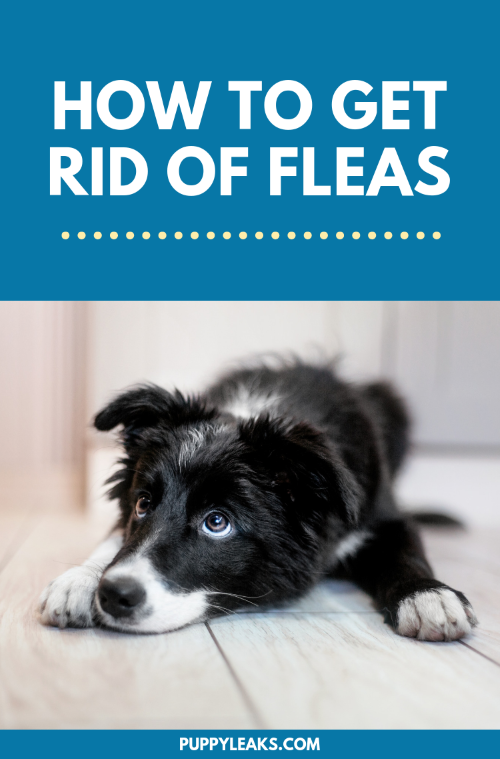
Please share with your friends
Recommended Reading:
Source: https://www.puppyleaks.com/dog-fleas-signs-symptoms-treatment/
0 Response to "Dog Becoming Infested With Fleas Continuously"
Post a Comment